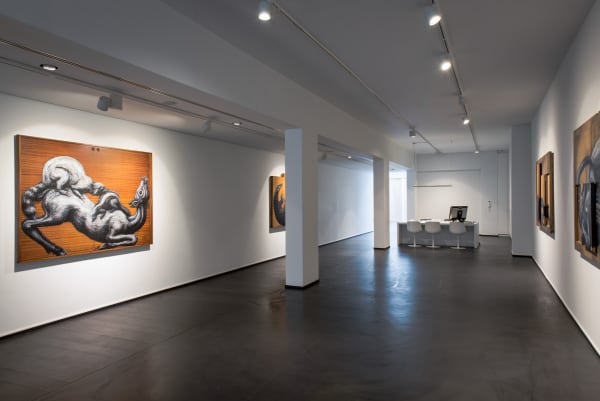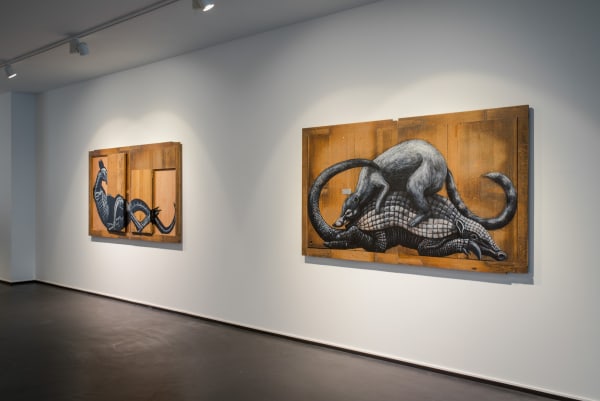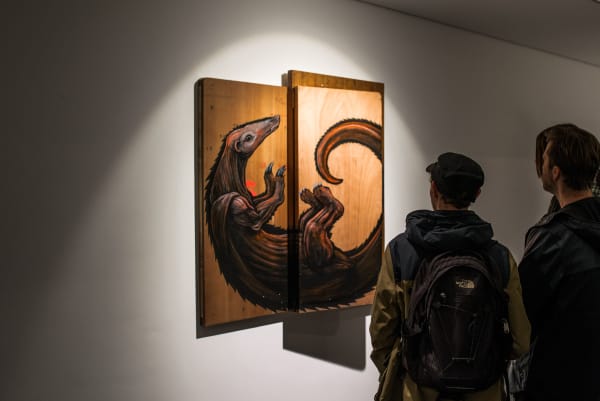roa: cataclysm
Past exhibition
Overview
KETELEER GALLERY is pleased to present Cataclysm, ROA's first exhibition with the gallery. The exhibition consists of an entirely new series of works, and a large scale sculpture.
Suddenly there was man. We’re stuck with that. And we don’t always understand. The transition of animal to man… when did this occur? Was there even a transition? Assuming that the African elephant shrew – also called jumping shrew or sengi – was the only animal who survived after the extinction of dinosaurs, we can’t forbear to assume that man has ‘become’ out of it. Man as the final chapter of evolution. Roa , born in Ghent, Belgium (1976), is considered to be one of the most influential contemporary ‘mural artists’. In a short amount of time he managed to assert himself worldwide. His typical and distinct style – black and white paintings of endangered and/or extinct animal species – immediately catches the eye of the passer-by. Nature, as he highlights, is a wondrous web of organic life, a natural unity animated and moved by joint forces. His vision of life on earth as a network of intriguing creatures inextricably linked to each other isn’t merely a fantastical idea but reality. In the 19th century geologists discovered that the planet was millions of years older than what the bible seemed to suggest (6000 years). During those millions of years lots of species had become extinct. Nature was/is exceptionally cruel as biologist Charles Darwin concluded in On The Origin of Species: ‘Every species is under constant threat of annihilation, especially young animals suffer…’. Cataclysm refers to the origin of things, the continual creation and extinction of living species – the so-called ‘circle of life’ and the endless battle for survival.
Press release
A gallery space like a terrestrial globe, where Roa examines and communicates his thought processes – bringing to life extinct animal species of (nearly) all continents. Here in this biotope he recreates. Creeping, cautiously, trusting his instincts. There’s an animalistic quality to the way he observes his surroundings, scoping and scanning. There’s a total surrender on the canvas, between him and this other creature that emerges, like a second breath. The monkey and the shrew – a reference to the origin and evolution of mankind – have ‘fitted’ themselves into the boundaries of the canvas-frame. The monkey is looking out meekly, in a subdued pose. The ‘surviving’ shrew seems to have a comfortable position, having a mildly amused look on its face – an inside joke? This bottom dweller is most probably used to having to crawl through the underwood which in emergencies can prove to be an excellent escape route… The doe (North America) seems to be literally falling into the decor – within the frame she tries to support her companions: the raccoon and the skunk. The kangaroo (Australia) on the other hand seems to have found balance leaning onto his powerfully muscled tail, like a third leg, cushioning his ‘fall’ into the tableau. The hog (Europe) however obliviously and untroubled nuzzles on, unaware of the fox and the hare who’ve nestled onto his back…
There’s no way to step out of one’s skin. That’s beyond our control. Roa does it anyway. Bodily resembling man, he internally takes on a anthropomorphic shape of the other living creature. He considers not man, but animals the central entity, the most significant of the universe. As a great naturalist he embraces the idea of animals being the sole possible survivors – everything beginning an ending in chaos, constitutes, for him, the natural state of things. We sometimes wonder about the essence of art, whether or not art is a genesis in our historical existence, or under which condition it can be. Roa poses that art evokes the same feelings of wonder within man as does the wild virginity of nature. Our mind gets so permeated with the image that we seize to have any attention for anything else. It’s this kind of ecstatic loss of control which permits us to be completely engulfed by the experience causing our critical abilities, intrinsically human, to make way for empathy. “Exploration of nature, more specifically – of the animal world, can lead to increased empathy. It teaches you something substantial about how one should live a good life”.
The artist carefully selects his wooden canvases. It’s not sufficient that the recycled wood has a certain structure, grain or patina. Here too, past and present seem connected – religion and science unite like two windmills caught up in each other’s vanes… the European tableau (hog, fox, hare) together with the South American (giant armadillo, bear face), African (aardvark, honey badger, fennec fox) and Australian (kangaroo) tableaux resemble kneeling, praying people – a canvas as a confessional? A 18th century Breton church floor once belonging to an abbey in Rennes now functions as a backdrop for one of these scenes. Not just the endangered species but also the wood floors and panels get a second life – undoubtedly relieved to be freed after more than 200 years of being impregnated with the echoes of choirs and celestial sermons… The whole oeuvre unfolds like a book, appearing to be read like a genesis story about good an evil. Hinged shutters attached to the panels make the work look like a cabinet. Behind the shutters we discover an anatomical sketch or a skeleton print of the endangered (or extinct) species pointing out the fragility and transience of life: the shutter as a partition between life and death.
The diorama truly puts us inside the decor. The artist’s devotion is radiating from the walls – a laudatory poem for the endangered, dying elephant and the rhino and no less, for the endangered giraffe. The spectator can’t turn a blind eye to it. For a moment it appears as if the elephant is carrying, hauling or pushing along his own skeleton in the vain hope for a new beginning, somewhere. The rhino in his way seems to be clinging onto a future existence. The giraffe assumes an apparent foetal position as if he wishes nothing more than to be reborn, one day, in the circle of life. The spectator can’t turn a blind eye. In this period room of continual regeneration he is confronted and made aware of, first of all, himself. And although the whole exhibition revolves around animals, it’s in essence about mankind. The desire grows to return to the root – worshipping wilderness as a source of healing powers and ecstasy, of calmness and serenity – a garden of Eden. An attitude increasingly having to lead the way in our modern ecological movement.
“If there is a God”, Roa concludes “it must be a woman, because out of her everything is born…” we should experience nature correspondingly, as the birth of an epiphany – a sudden revelation of seeing nature and its fauna as a living whole rather than (merely) an endangered one. This is how we experience the unicity of Roa’s work: as the birth of a new Romanticism arisen from a nostalgic desire to return to the origin of things.
Kathy de Nève, October ‘17
Installation Views








